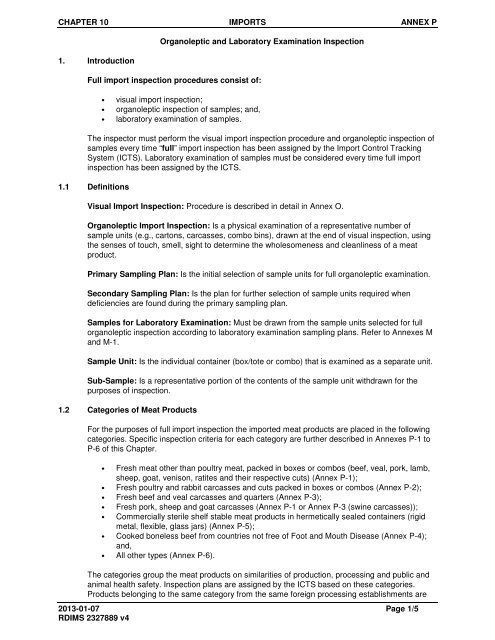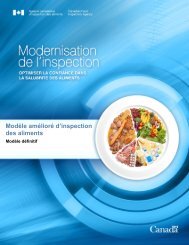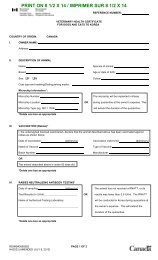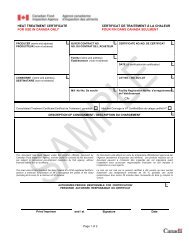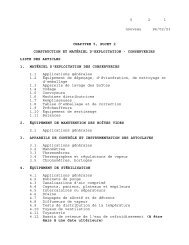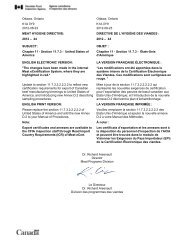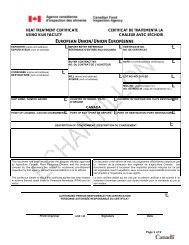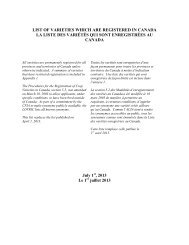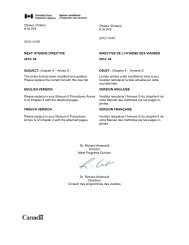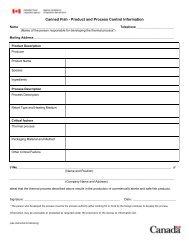PDF (342 kb ) - Agence canadienne d'inspection des aliments
PDF (342 kb ) - Agence canadienne d'inspection des aliments
PDF (342 kb ) - Agence canadienne d'inspection des aliments
You also want an ePaper? Increase the reach of your titles
YUMPU automatically turns print PDFs into web optimized ePapers that Google loves.
CHAPTER 10 IMPORTS ANNEX P1. IntroductionOrganoleptic and Laboratory Examination InspectionFull import inspection procedures consist of:• visual import inspection;• organoleptic inspection of samples; and,• laboratory examination of samples.The inspector must perform the visual import inspection procedure and organoleptic inspection ofsamples every time “full” import inspection has been assigned by the Import Control TrackingSystem (ICTS). Laboratory examination of samples must be considered every time full importinspection has been assigned by the ICTS.1.1 DefinitionsVisual Import Inspection: Procedure is <strong>des</strong>cribed in detail in Annex O.Organoleptic Import Inspection: Is a physical examination of a representative number ofsample units (e.g., cartons, carcasses, combo bins), drawn at the end of visual inspection, usingthe senses of touch, smell, sight to determine the wholesomeness and cleanliness of a meatproduct.Primary Sampling Plan: Is the initial selection of sample units for full organoleptic examination.Secondary Sampling Plan: Is the plan for further selection of sample units required whendeficiencies are found during the primary sampling plan.Samples for Laboratory Examination: Must be drawn from the sample units selected for fullorganoleptic inspection according to laboratory examination sampling plans. Refer to Annexes Mand M-1.Sample Unit: Is the individual container (box/tote or combo) that is examined as a separate unit.Sub-Sample: Is a representative portion of the contents of the sample unit withdrawn for thepurposes of inspection.1.2 Categories of Meat ProductsFor the purposes of full import inspection the imported meat products are placed in the followingcategories. Specific inspection criteria for each category are further <strong>des</strong>cribed in Annexes P-1 toP-6 of this Chapter.• Fresh meat other than poultry meat, packed in boxes or combos (beef, veal, pork, lamb,sheep, goat, venison, ratites and their respective cuts) (Annex P-1);• Fresh poultry and rabbit carcasses and cuts packed in boxes or combos (Annex P-2);• Fresh beef and veal carcasses and quarters (Annex P-3);• Fresh pork, sheep and goat carcasses (Annex P-1 or Annex P-3 (swine carcasses));• Commercially sterile shelf stable meat products in hermetically sealed containers (rigidmetal, flexible, glass jars) (Annex P-5);• Cooked boneless beef from countries not free of Foot and Mouth Disease (Annex P-4);and,• All other types (Annex P-6).The categories group the meat products on similarities of production, processing and public andanimal health safety. Inspection plans are assigned by the ICTS based on these categories.Products belonging to the same category from the same foreign processing establishments are2013-01-07 Page 1/5RDIMS 2327889 v4


